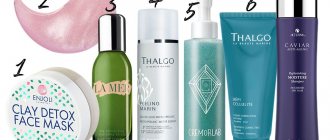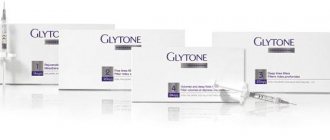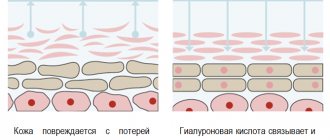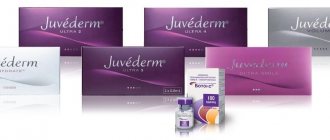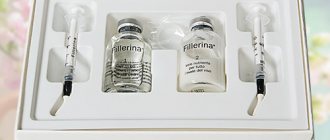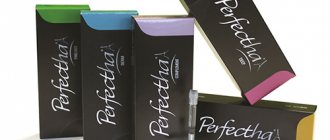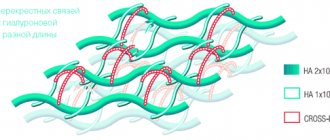Today, contour plastic surgery is one of the most popular methods for quickly and effectively eliminating such aesthetic imperfections as aging and loss of skin elasticity. This rejuvenation effect is achieved by introducing special absorbable gels – fillers – into the dermis. So what are fillers, and how does hyaluronic acid work in them?
All contouring preparations contain stabilized hyaluronic acid of non-animal origin (Non-Animal Stabilized Hyaluronic Acid (NASHA). Non-animal HA is obtained by biotechnological means, so there is absolutely no risk of an allergic reaction, no preliminary testing is required.
In more outdated preparations, non-absorbable materials (biopolymer gel) and HA of animal origin were first used. At the moment, both the biopolymer and HA of animal origin are recognized as dangerous to humans and are prohibited for use in the Russian Federation due to their non-biocompatibility. The concept of “biocompatibility” is defined as “the ability of a material to achieve the appropriate response in the body in each application.” HA itself is completely biocompatible. The biocompatibility of NASHA has been extensively studied in vitro and in vivo. Testing was carried out in accordance with ISO (International Organization for Standardization) standard 10993 for “Biological evaluation of procedures used in medicine.”
Biocompatibility tests have demonstrated that hyaluronic acid:
- does not have cytotoxicity or genotoxicity;
- does not cause acute, subacute or chronic effects;
- does not cause hypersensitivity reactions.
Officially, Roszdravnadzor allows the distribution and use of only dermal implants (as fillers are officially called), which contain exclusively synthesized hyaluronic acid, or HA of non-animal origin. Such drugs include Genyal fillers.
How does GC work?
Stabilized Hyaluronic Acid molecules are capable of holding huge amounts of water. This unique ability of HA allows you to preserve the effect of the contour modeling procedure for a long time. Hyaluronic Acid (HA) is a substance that is not only a component of the tissues of all organisms, but is also identical in structure in all living beings. HA plays an important role in the body by binding and retaining water in the skin, creating volume in the eyeball, maintaining the elasticity of joints, ligaments, etc.
Stabilized Hyaluronic Acid in its pure form is very quickly destroyed by the body's enzyme system. To slow down the process of biodegradation and retain HA in tissues, manufacturers of contouring products conduct thousands of scientific studies and develop more and more stable forms of the acid molecule. In earlier fillers (first generation fillers), HA was stabilized by special chemical impurities, which over time caused allergic reactions. Gradually, manufacturers found a safer way for the patient to stabilize HA - with the help of glycerol, which is also found in our body and therefore is not a potential allergen.
In Genyal preparations, which are the third generation of fillers, hyaluronic acid is stabilized by glycerol, which eliminates the risk of allergic reactions or filler rejection.
"Sculptra". Preparation based on poly-L-lactic acid
Polylactic acid has been known as a medical suture material for more than 20 years, and the first fillers appeared in the late 90s.
Pros of polylactic acid:
- This product acts as a deep filler.
Recently, injections of polylactic acid are administered not with the aim of replenishing missing volume or filling wrinkles, but to stimulate the formation of one’s own collagen cells and thereby create a lifting effect. Today, polylactic acid is not injected into the eyebrow or nasolabial folds. Its calling is to tighten the oval of the face or replenish the volume of its individual zones (for example, cheekbones, cheeks). The advantage of polylactic acid is its long-lasting effect – up to 2 years.
Cons of polylactic acid:
- Since this filler is very dense, according to the injection technique, it must be injected into the deep layers of the skin. When administered superficially, it will be noticeable on the surface of the skin in the form of small nodules. As a result, instead of the expected rejuvenation effect, the face will become lumpy. In addition, this filler can only be administered by a professional with extensive experience working with polylactic acid, since its introduction involves compliance with many rules.
The main difference from hyaluronic acid is that polylactic acid triggers the process of elastin synthesis. Collagen is always present in our skin. Its production occurs during any injury. But to give the skin an even color, it also needs elastin.
How do fillers work?
The elastic particles of gels in preparations for contouring can be compared to building blocks. When injected, the “blocks” form a supporting frame in the area of folds and wrinkles, smoothing out skin defects and creating a surface lifting effect. In this way, you can remove both fine and deep wrinkles and creases, giving the skin a more youthful and radiant appearance. In addition to the tissue “filling” effect, HA is capable of attracting large amounts of moisture, which promotes enhanced skin hydration.
Indications for the contour plastic procedure:
- correction of facial contour deformities
- changing the shape and increasing the size of lips, cheekbones, cheeks, chin
- face oval correction
Optimal results in correcting age-related changes are achieved if the defect can be completely leveled by stretching it with your fingers. The degree of correction and duration of the effect of the procedure are strictly individual and depend on the structure of the skin defect, the volume of injected material, the technique of inserting the implant, as well as the age, facial activity and lifestyle of the patient. Practice shows that in most patients after 6 months the effect remains 50-80%.
Genyal brand fillers are very flexible and easy to use, and the correction effect lasts from 8 to 18 months.
The mechanism of the volumizing effect during correction with agarose-based fillers
O.Z.: The uniqueness lies in the fact that the main component of Algeness products is agarose. This polymer is extracted from brown algae and is believed to be the drug that gives volume.
However, it is not hydrophilic and does not “pull” water onto itself as hyaluronic acid does.
Therefore, the subtleties of working with this drug when correcting with fillers are that the cosmetologist must clearly know: how many milliliters to use in a particular area, fold or when correcting the lips with fillers, as well as volumizing the zygomatic area. What is of great importance here is, first of all, the doctor’s technical skills in working not only with this drug when correcting with fillers, as well as deep knowledge of the rheological properties of the Algeness line.
Ideal threads for thread lifting
If we are working on correction with fillers with hyaluronic acid, then it is possible to add the drug in the future and thus the doctor can adjust the required volumes. When using Algeness fillers presented, you must clearly know the methodology and amount of the drug for correction, since there is no additional hydration. As a result, the amount of product used by the doctor during filler correction will remain in this area. This is both the advantage of correction with Algeness fillers and the difficulty.
Techniques for introducing fillers into various areas of the face
Depending on the area targeted for correction, contouring preparations are injected into different layers of the skin. During the procedure, the doctor uses various techniques for administering drugs.
1. Techniques for correcting nasolabial folds and wrinkles on the bridge of the nose:
- Linear injection technique: a continuous line of gel is formed along the entire length of the wrinkle/fold, lifting the skin at the injection site to the desired level.
- Point injection technique: injections are placed pointwise along the line of the wrinkle/fold being corrected, merging into a single soft continuous line.
2. To create additional volume of tissue, as well as for deep folds, the “Fan” and “Lattice” injection techniques are used. These techniques, with minimal trauma to the skin, allow you to create an even supporting frame inside the dermis.
What do you need to know before undergoing Algeness® filler treatment?
Is Algeness® right for you?
Fillers are 100% natural, so they are suitable for those who want to restore youth, fill wrinkles and correct the contours, shape and volume of the face.
Is the procedure painful?
Beauty secrets from Madonna: avoid dining in restaurants and other catering establishments, give preference to a balanced diet; include grains, vegetables, fruits and fish in your diet; products containing sugar and alcohol are prohibited; jog for 45 minutes every day and do fitness 3 times a week; use a homemade mask for the skin around the eyes (mix 25 g of butter, 10 ml of chamomile infusion, 5 ml of castor oil and apply 10 minutes before washing your face in the morning).
All injections cause an unpleasant feeling and pain. However, the doctor may decide to apply local anesthesia (such as numbing cream) to the injection area. The injection area will become numb. The procedures are relatively painless, although there may be some discomfort during the session and the client may feel pressure from the needle.
What are the side effects?
There may be slight discomfort during the procedure. Once completed, there may be some redness around the injection site and some swelling, which may last 1 to 2 days.
Post-procedure care
After the procedures, you should not touch your face with your hands or any cosmetic devices (sponges, brushes, etc.) to avoid infection through punctures. You can apply makeup one day after the procedure. It is recommended to apply sunscreen for 5-10 days after injections to prevent hyperpigmentation.
For three days, it is not recommended to engage in sports or swimming, or expose your face and body to hot temperatures (baths, saunas, solariums).
Preparation based on calcium hydroxyapatite microspheres Radiesse
Volumizer Radiesse™ (Radiesse) is a dermal filler based on calcium hydroxyapatite, registered in Europe and approved by the US FDA (Food and Drug Administration. It works as a filler and stimulates the production of its own collagen. Unlike fillers with hyaluronic acid, Radiesse™ (Radiesse) provides correction not for 4-9 months, but for 12-15 and longer. The drug does not cause an inflammatory reaction in tissues, does not migrate and is completely eliminated from the body over time.
Radiesse™ consists of microspheres of synthetic calcium hydroxyapatite (CaHA) (30%) suspended in an aqueous gel carrier (70%).
Calcium hydroxyapatite (CaHA) particles are produced from sub-micron grains of the parent material. These grains are combined during high-temperature processing into microspheres:
- CaHA (calcium hydroxyapatite) microspheres have the same shape, the size varies from 25 to 45 microns in diameter
- Ca2+ and PO3- ions are natural components of teeth and bones, making them known to be safe and biocompatible
- Calcium hydroxyapatite CaHA in the Radiesse™ filler is not bone, it is an inorganic component of the tissue of teeth and bones
- The carrier gel holds the microspheres together.
Thus, the duration of the effect is ensured not only by the long-term presence of the drug itself in the tissues, but also by the development of its own tissue.
Contour plastic surgery using Radiesse™ can solve a wide range of skin problems. These include:
- restoration of volume in the cheekbones and cheeks,
- hand rejuvenation,
- non-surgical rhinoplasty - correction of the bridge of the nose,
- correction of the oval face and chin (non-surgical lifting),
- elimination of nasolabial folds and marionette lines.
Fillers from the Ellanse line
This sterile, completely self-absorbing dermal implant, developed and manufactured by AQTIS Medical BV (Netherlands), is a biostimulator and, unlike other dermal fillers, has stable effectiveness, a unique predicted duration of action from 1 year (Ellanse-S) to 4 years ( Ellanse-E) and complete and predictable biodegradation (STaT technology). Ellanse consists of perfectly smooth spherical polycaprolactone (PCL) microspheres (25-50 µm-30%), without cross-links, uniformly suspended in a special water-based carboxymethylcellulose (CMC) gel carrier (70%).
It should be noted that polycaprolactone has been widely used in medical practice for 40 years, its use is approved by the US Food and Drug Administration (FDA). In particular, it is well known as a biodegradable (breaks down and is completely eliminated from the body) soft medical suture material. Biocompatibility, complete absorption, elasticity of this polymer, absence of side effects - these are the qualities that became the key reason for the creation of a dermal filler based on it. This is certainly an alternative to hyaluronic acid with a high safety record.
